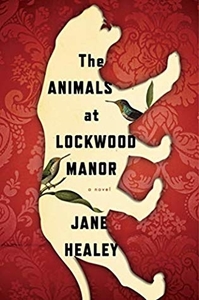The Animals at Lockwood Manor is an atmospheric gothic novel from debut author Jane Healey. Set during World War II in an English country house, it contains all the genre’s staples – supernatural disturbances, hidden rooms, spooky dreams, dark family secrets – along with a good helping of sapphic romance. If you’ve ever read Jane Eyre and thought “OK, but what if Jane fell in love with Bertha Mason instead?”, then this is one for you!
When the Natural History Museum’s collections are evacuated during the London Blitz, a menagerie of taxidermied mammals are sent to Lockwood Manor – along with their newly-promoted director, Hetty Cartwright. What with the manor’s imperfect storage conditions, the creepy atmosphere, the unwelcoming servants, and Major Lockwood’s sexist arrogance, Hetty would have enough trouble keeping her collection in order. But then some of the animals start to go missing.
While Hetty investigates who’s responsible for her missing charges, she grows closer to the Major’s delicate daughter, Lucy. Lucy’s mother and grandmother both passed away recently in a horrible car accident, causing Lucy’s childhood nightmares and sleepwalking to relapse. In her dreams, she wanders the house, desperately searching for a room that doesn’t exist, and remembering her mother’s warnings about la diablesse – a devil-woman in white who haunts the manor.
The romance between Hetty and Lucy is slow to build, and it’s touching to watch them slowly discover their attraction to one another. Healey is a master at ‘show don’t tell’ when it comes to her characters’ feelings.
And how could I review this without mentioning the eponymous animals? The taxidermied collection in Hetty’s care are characters in their own right: the truant panther, the faded hummingbirds, the towering polar bear. Hetty worries about them constantly, and you feel invested in their welfare too.
Then there are the human animals. Throughout the novel, Hetty compares other characters to the creatures in her care: Lucy is a cat, the housekeeper is a Rüppell’s fox, one of the maids is a chipmunk. This adds a fun flare to character descriptions, but also reflects that people can be just as beastly as animals – particularly Hetty’s host, Major Lockwood.
The Major is a wonderfully dislikable antagonist. He reminds me of gothic leading men like Rochester, Heathcliffe, or Maxim de Winter. Except that instead of asking us to believe he’s actually a romantic love interest (despite his patriarchal beliefs, violent temper, and mysteriously dead wife), Healey lets him be the villain of the piece. As someone who always wants gothic heroines to realise how awful their leading men are, I appreciate a novel that finally gives me what I’m looking for!
I’m a big fan of gothic literature, so I was delighted by Healey’s inclusion of so many classic gothic elements. If there’s a gothic trope you can think of, it’s probably in this book. Despite this, the story doesn’t feel predictable or formulaic – the tropes are thrown in more like nods to Healey’s predecessors. You can feel the influence of Jane Eyre (fun fact: Healey was named after her), Rebecca, The Haunting of Hill House, Angela Carter, The Woman in White – and probably a load more that I’ve missed on my first reading.
If you’re a fan of gothic or historical fiction – particularly authors like Sarah Waters, Laura Purcell, and Daphne du Maurier – then I would highly recommend The Animals at Lockwood Manor. It’s a tense, claustrophobic read, full of opulent descriptions and chilling twists. The novel is published on 5 March by Mantle in the UK and 10 March by Houghton Mifflin Harcourt in the US.


